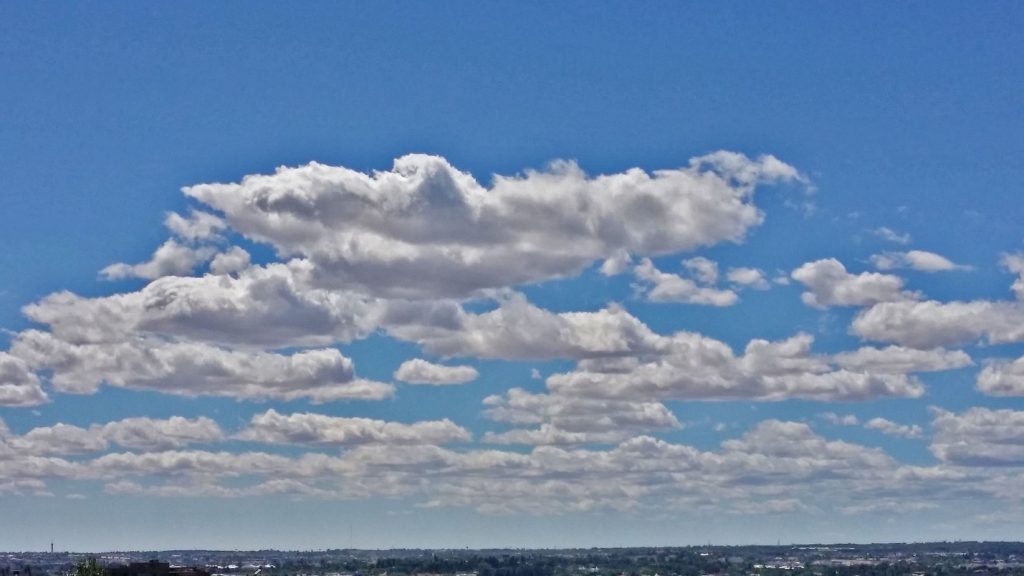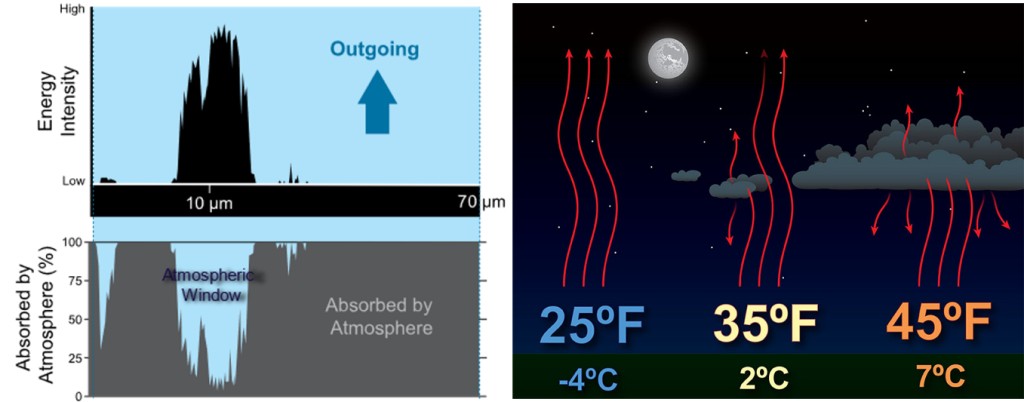2.3 Atmospheric Influences on Insolation
Another word for incoming solar radiation is insolation. Since shortwave radiation comes from the Sun, insolation can also be thought of as incoming shortwave radiation. The previous module examined details of electromagnetic radiation as it exits through the atmosphere. The variable gases were important in these analyzes since they absorb heat. However, a definition of “absorb” has never been given. This submodule corrects that omission, along with examining the reflection and scattering characteristics of the atmosphere. This submodule completes the knowledge needed to understand how the atmosphere interacts with shortwave and longwave radiation.
2.3.1 Absorption and Reflection
Absorption
Absorption is when the atmosphere intercepts radiation, gains energy and warms. The gas molecules in air are not all equal in absorbing every wavelength. As covered previously, most of the insolation reaching the Earth’s surface passes through the atmosphere. However, the atmosphere does absorb some incoming radiation as is shown in this diagram.

The yellow area is insolation at the top of the atmosphere. The red area is what is received at sea-level. Water vapor (H2O) has the largest absorption of insolation in the near infrared band (greater than 780 nm). You may notice that the Sun does not feel as hot on humid days, because water vapor is absorbing some of the Sun’s infrared energy. Additionally, carbon dioxide absorbs a little in the near infrared wavelengths and of course ozone (far left) absorbs ultraviolet.
Reflection
Reflection occurs when radiation strikes an object and is redirected away from it. The best analogy of reflection is a mirror. All objects reflect some light which enables us to see them. Clouds are both an absorber and a reflector.

Albedo is the percent of insolation reflected by an object. Fresh snow has the highest albedo at 75 to 90%. Asphalt has one of the lowest at 5 to 10%. The following table contains the various albedos of objects. Notice that Earth’s average albedo is 30%. Hence, 30% of incoming shortwave radiation is reflected by the Earth.
| Surface | Albedo |
|---|---|
| asphalt road | 5 – 10% |
| cities | 14 – 18% |
| forest | 14 – 20% |
| crops and grassland | 10 – 25% |
| lakes and ocean | 10 – 60%
varies with Sun angle |
| fresh snow | 75 – 90% |
| Earth as an average | 30% |
Video: Mod 2.3.1 Absorption and Reflection (6:49 min.)
This video discusses what occurs with absorption in air, reflection and albedo.

2.3.2 Scattering
Scattering is the dispersion of radiation in multiple directions when it strikes an object.

The characteristics of this scattering are determined by the size of the suspended atmospheric particles. Three general categories of scattering are:
- Rayleigh (pronounced “ray-lee”) scattering happens with the smallest size particles like molecules.
- Mie (pronounced “me”) scattering occurs with medium size particles like dust.
- Nonselective scattering happens with the largest size particles like water droplets.
Rayleigh scattering occurs when the object is smaller than about 1/10 the wavelength of the incoming shortwave radiation. The gas molecules in the air fit this category. Rayleigh scattering affects shorter wavelengths more than longer wavelengths and is more effective with visible light. Shorter wavelengths are the blue and violet colors, although our eyes see blue much better than violet.

Light from the Sun consists of all wavelengths. As this light interacts with the atmosphere, blue light is scattered more than the other colors. This scattering is why the sky is blue. The question now is why are sunsets and sunrises sometimes red? The answer to this question is that the light is passing through more atmosphere with a low sun angle at sunrise and sunset. The more atmosphere affecting the scattering of the light, the more the shorter wavelengths are scattered. Eventually only the predominant red and orange colors are left in the light.
Video: Why is the Sky Blue (& the Sunset Red) – (10:00 min.)
This video explains Rayleigh’s scattering in detail.
Mie scattering occurs when atmospheric particles’ diameters are larger than the wavelength of the radiation. Most atmospheric particles of this size fall in the aerosol (dust) category. Mie scattering disperses light predominately forward, rather than omnidirectional like Rayleigh scattering.
Mie scatters do not favor any wavelength and tend to amplify the existing light. When Mie scattering is occurring a whitish or grayish color is present. Many times, Mie scattering can be observed when looking towards the Sun in the morning and you notice a haze is present. Turn around so the Sun is at your back and the haze disappears. Landscape photographers are aware of this visual aspect and prefer the Sun behind them for a clearer picture.

Nonselective scattering occurs with all particles larger than aerosols, like cloud droplets. Non-selective scatters reflect all wavelengths equally, and clouds are the most important particle in this category. The reflection of incoming shortwave radiation due to clouds is due to nonselective scatters. The scatters tend to be white or gray in color.

An interesting aspect of nonselective scattering is when clouds occur during the night. During the night, outgoing longwave radiation primarily escapes to space through the 10 µm window. Remember this diagram?

As clouds come overhead, their nonselective scattering property closes this window. Outgoing longwave radiation is greatly reduced, which in turn increases the temperatures during the night. This diagram illustrates this concept well. A simple way to remember this concept associated with clouds is “clouds act as a blanket at night”.
Video: Mod 2.3.2 Scattering (4:16 min.)
This video talks about scattering.

